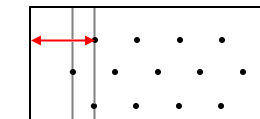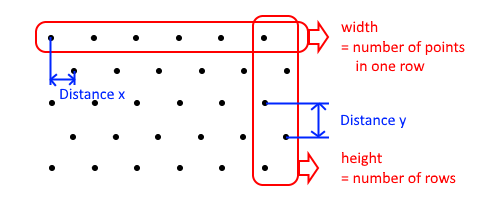Asymmetrical circles pattern
An asymmetric circle pattern is similar to a symmetric circle pattern, except that every second row is offset by half a column. This allows a smaller distance between two rows, allowing more lines in the same area.
Pattern requirements
- The pattern should be applied to a surface that is as flat as possible (planar), e.g. a glass pane.
- The circles should be as equal in size as possible.
- A sample must consist of at least 9 points.
- The circle centers must be applied at the same distance horizontally and vertically. The distance must be large enough to ensure that the circles do not touch each other and are recognized as separate objects.
- The background color around the pattern must form a 'quiet zone'.
Requirements for the image acquisition
- Exposure
- Homogeneous illumination of the pattern.
- Good contrast between circles and background.
- Figure
- Perspective distortions should be kept to a minimum.
- The standard specifications of the Advanced Calibration Options must be adhered to or adapted. By default, a circle must be represented by an area of at least 25 pixels and a maximum of 15000 pixels. The area should not be too small, otherwise interference from the background will be picked up.
Configuration in the Camera Calibration Assistant
- Start indent
The first row is indented relative to the second. - Width
Corresponds to the number of circles per row. - Height
Corresponds to the number of circles per column. - Distance x
Corresponds to the distance to the nearest circle center in horizontal direction (across rows). - Distance y
Corresponds to the distance to the nearest circle center in vertical direction (within a column). - Color inverted
When a light pattern is used on a dark background.

